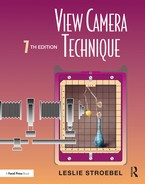Contents
1.3 Lateral, Vertical, and Angular Adjustments
1.8 Advantages and Limitations of View Cameras
2.3 Focusing and Depth of Field
2.6 Controlling the Plane of Sharp Focus
2.7 Simultaneous Use of Tilts and Swings
2.8 Vertical and Horizontal Shifts
2.10 Effect of Back Movements on Image Shape
2.11 Effect of Back Movements on Image Sharpness
2.12 Effect of Lens Movements on Image Sharpness
2.13 Types of Movement Limitations
2.15 Lens Movement Limitations
2.16 Back Movement Limitations
3.1 Image Formation with a Pinhole
3.2 Image Formation with a Simple Lens
Center and Radius of Curvature
3.4 Image Formation with a Multiple-Element Lens
3.5 Typical Image Formation Problems
4.1 Camera and Photographic Exposure
4.4 Maximum Diaphragm Openings
4.5 Minimum Diaphragm Openings
4.7 Limitations of the f-Number System
4.8 Supplementary Lenses and Effective f-Numbers
4.10 Lens and Focal Plane Shutters
5.1 Basic Differences Between Lenses
Variable Focal Length and Zoom Lenses
6.2 Focal Length with Distant Objects
6.3 Focal Length Limitations at Close Range
6.4 Maximum Scale of Reproduction
Scale of Reproduction and Bellows Extension
Scale of Reproduction and Focal Length
Scale of Reproduction, Focal Length, and Object Distance
6.5 Closeup Photography, Photomacrography, and Photomicrography
6.6 Image Definition of Photomacrographs
Use a Positive Supplementary Lens
Substitute a Lens Designed for Use with Shorter Object Distances
6.7 Lighting for Photomacrographs
6.9 Object Distance and Perspective
6.10 Focal Length and Perspective
6.11 Simultaneous Changes in Object Distance and Focal Length
6.12 Use of Camera Movements Versus Changing Object Distance
6.13 Apparent Perspective Effects
7.2 Viewing Distance and Cropping
7.4 Swings and Tilts, and Depth of Field
7.8 Checking the Depth of Field
7.9 Calculating the Depth of Field
8.2 Effects of Underexposure and Overexposure
8.4 Reflected-Light Exposure Meters
8.5 Incident-Light Exposure Meters
8.6 Reflected-Light Exposure Meter Readings
8.8 Midtone Reflected-Light Readings
8.12 Limitations of Reflected-Light Readings
8.15 Limitations of Incident-Light Readings
8.17 Electronic-Flash Exposure Meters
8.18 Causes of Inaccurate Exposure
9 Light-Sensitive Materials and Film Processing
9.2 Film and Picture Proportions
9.6 Characteristics of Black-and-White Film
9.10 Contrast and Tone-Reproduction Characteristics
9.14 Nonsilver Light-Sensitive Materials
Blueprint (Cyanotype, Ferro-Prussiate)
Tray Processing of Black-and-White Film
10.3 Filters for Black-and-White Photography
10.4 Predicting Filter Effects
10.7 Exposure Adjustment for Filters
10.8 Using the Maxwell Triangle
10.9 Correction Filters for Black-and-White Film
10.13 Filters for Color Photography
10.14 Filters for Black-and-White and Color Photography
11 Evolution of the View Camera
11.3 Ground-Glass and Film Holders
12.1 Camera Tripods and Stands
Vertical and Lateral Shift Movements
Camera Movements for Small-Format Cameras
12.10 Lens and Shutter Controls
12.12 Modular View Cameras and Accessories
12.15 Computers and Digital Imaging
12.16 View Camera Features and Specifications
12.17 Contemporary View Cameras and Prices
12.18 Table of Features and Specifications
